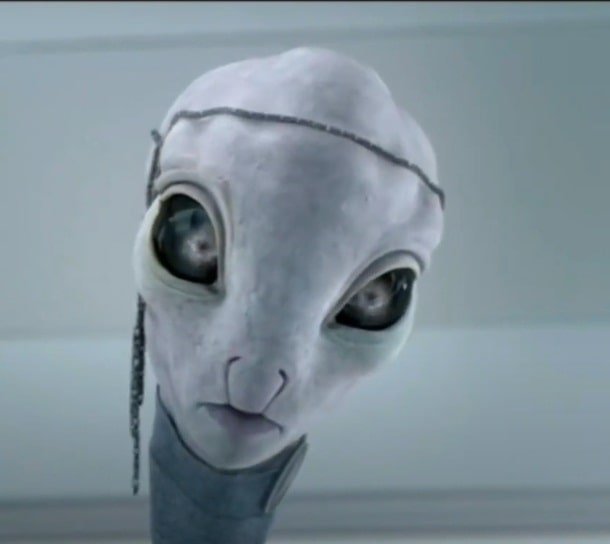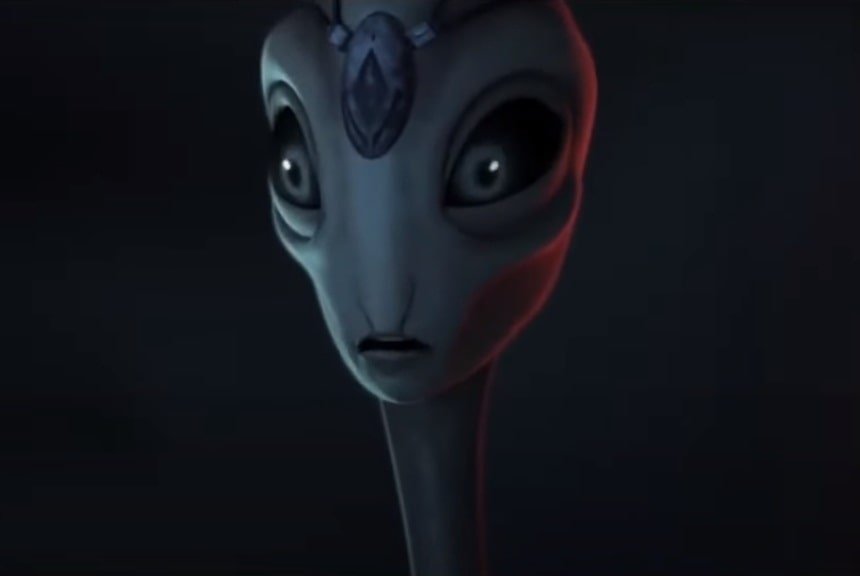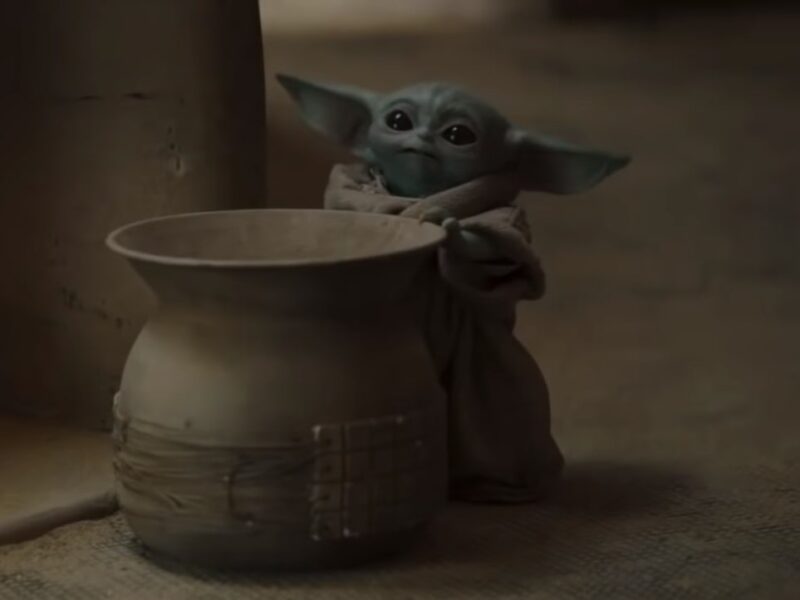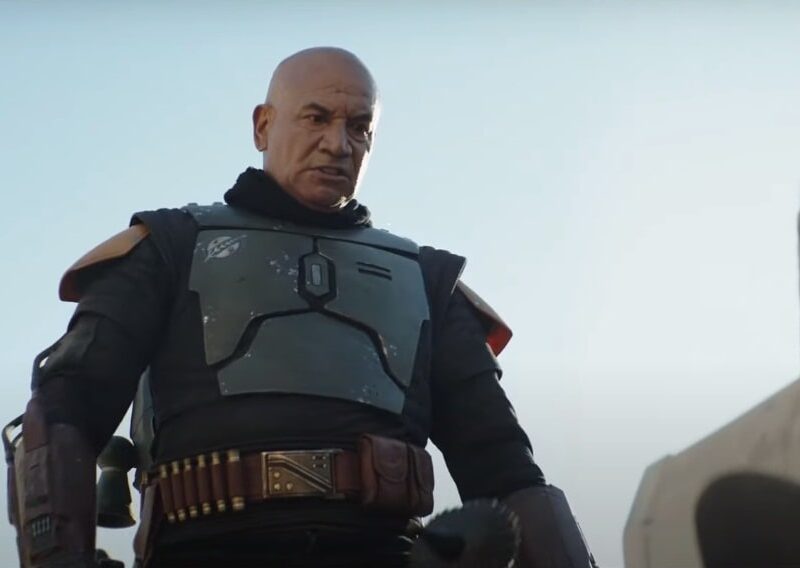1. Who are the Kaminoans?

The Kaminoans were a tall, slender, amphibious species of sentient beings native to the aquatic planet Kamino located in Wild Space.
Living in large domed cities elevated on stilts above the ocean, Kaminoans became renowned for their expertise in cloning and genetic engineering, in addition to developing other advanced, non-biomedical technologies for various clients, including the Galactic Republic.
2. Homeworld of the Kaminoans: The Planet Kamino

Kamino is a remote, water-covered planet situated on Wild Space beyond the Outer Rim Territories. Constantly besieged by torrential storms, its surface is entirely covered by ocean, with only massive cities perched atop towering platforms visible above the waves.
Kamino’s location is a point of intrigue in the Star Wars saga. At some point before the events of Attack of the Clones, the planet existence was erased from the Jedi Archives by Count Dooku, leaving it hidden from galactic awareness for years. This isolation was both physical and political, allowing the Kaminoans to focus on their genetic experiments away from the scrutiny of the wider galaxy.
3. Physical Characteristics
Kaminoans were graceful, pale-skinned humanoids with elongated necks and oblong heads that sat on flexible neck bones. They had large, almond-shaped black eyes with white pupils, enabling them to see in the ultraviolet spectrum.
Male Kaminoans had fin-like crests on their heads, while females were bald and adorned with unique head crescents. Their long, fragile limbs gave them an elegant, gliding walk, and their small feet were adapted to Kamino’s firm seabeds and the later hard surfaces of their cities. Kaminoans reached adulthood by the age of 11.
4. Society and Culture
The Kaminoans resided in cities that were enclosed and situated above Kamino’s ocean floor. Typically, they displayed minimal outward signs of emotion or personality, with their finest achievement being the creation of the clone troopers.
Known for their isolationist nature, Kaminoans engaged with outsiders only when it was financially beneficial. This isolationism stemmed from a great flood that altered their homeworld, after which they opted to modify their genetics and planet rather than seek aid from the Galactic Republic.
Although the Kaminoans managed to thrive on their own, this event left them wary of outside help. Despite their isolation, they didn’t consider themselves superior to other species but viewed other planets as distractions. Many Kaminoans believed all they needed existed on Kamino itself.
While they embraced scientific rationality, Kaminoans also maintained a tradition of making pilgrimages to the sunken ruins of their ancient cities. Both ancient and modern Kaminoan cities were marked by their domed architecture.
5. Role in Cloning
Historically, Kaminoans have been recognized as master cloners. They were commissioned by Jedi Master Sifo-Dyas around 33 BBY to create an army for the Galactic Republic, utilizing the genetic template of Jango Fett, a renowned bounty hunter. This initiative led to the development of the Clone Army, which became integral to the Republic’s military strategy during the Clone Wars.
Within their culture, there exists a complex ethical framework regarding cloning; while they excel in this field, they grapple with the implications of their creations. Key figures such as Lama Su, the Prime Minister of Kamino, and Taun We, his aide, played crucial roles in overseeing cloning operations.
6. Notable Kaminoans
6.1 Lama Su

Lama Su is one of the most prominent Kaminoans featured in the Star Wars saga. He serves as the Prime Minister of Kamino and is responsible for overseeing the cloning operations on the planet.
Lama Su played a crucial role in the creation of the Grand Army of the Republic by facilitating the contract with Jedi Master Sifo-Dyas to produce clone troopers based on Jango Fett’s genetic template. His character is depicted as highly intelligent and somewhat aloof, embodying the typical Kaminoan demeanor of detachment and focus on scientific endeavors.
6.2 Taun We

Taun We is another significant Kaminoan, known for her role as an administrative aide to Lama Su. She is involved in managing the cloning facilities and interacting with clients seeking cloning services.
Taun We is notable for her calm demeanor and professionalism, reflecting the stoic nature of her species. She assists Obi-Wan Kenobi during his visit to Kamino in Attack of the Clones, providing him with information about the clones and their creation process.
6.3 Nala Se

Nala Se is a Kaminoan scientist who also plays a critical role in the cloning operations. She is portrayed as a skilled geneticist who contributes to the development of the clones, including implementing behavioral modifications to ensure their loyalty to the Jedi.
Nala Se’s character adds depth to the ethical complexities surrounding cloning, as she grapples with her role in creating an army that would ultimately be used for darker purposes during the rise of the Galactic Empire.
7. History
7.1 Rise of Kaminoan Civilization
The Kaminoans developed their civilization on a planet isolated near the galaxy’s edge. Originating from the planet Kamino, located in Wild Space beyond the Outer Rim Territories, the Kaminoans once lived as a land-based species, despite maintaining a strong connection to the oceans.
Their world was emerging from an ice age, and the melting ice caused a great flood, submerging the land and forcing the Kaminoans to adapt. Initially relocating to higher ground, they later constructed tall, stilted cities to rise above the ocean’s surface. These towering structures replaced earlier wattle-and-daub buildings.
To travel between their cities, Kaminoans used aiwhas, large aquatic creatures. Although they could have sought assistance from the Galactic Republic, they chose to rely on their own capabilities, fearing colonization, resource depletion, and cultural erosion.
The Kaminoans also preserved many land-dwelling species, adapting both the planet’s flora and fauna to survive the drastic environmental changes. Their enclosed cities protected them from harsh winds and rainstorms while also housing the species they had saved.
7.2 Creation of the Grand Army of the Republic
Though isolated from much of the galaxy, the Kaminoans gained a reputation as master geneticists, particularly in the art of cloning. Kamino remained largely unknown to the galaxy, but whispers of their advanced engineering and genetic work circulated in some parts of the underworld.
For a time, the Kaminoans even maintained a cloning facility on the planet Bora Vio, though they eventually abandoned it, leaving behind the clones that had been created there. Jedi Master Sifo-Dyas discovered the Kaminoans and commissioned them to create a Grand Army of the Republic.
Though Kaminoans had built clone armies before, Sifo-Dyas’ request was especially ambitious, but they adapted and fulfilled his order. However, the Sith took control of the project after Darth Tyranus paid the Pyke Syndicate to assassinate Sifo-Dyas by shooting down his shuttle.
Tyranus also hired the bounty hunter Jango Fett to act as the genetic template for the clone army. The clones took ten years to mature, and when the army was ready, it was presented to the Republic.
Jedi Knight Obi-Wan Kenobi later visited Kamino while pursuing Jango Fett, who had been implicated in the plot to assassinate Senator Amidala. During his visit, Kenobi met with Kaminoan Prime Minister Lama Su, who believed Kenobi had come to inspect the Grand Army.
Shortly after, the Galactic Senate, under Supreme Chancellor Sheev Palpatine, who secretly held the identity of Darth Sidious, granted Palpatine emergency powers to utilize the clone army under the pretense of fighting the Confederacy of Independent Systems. The clones were first deployed under Jedi command during the First Battle of Geonosis, marking the start of the Clone Wars.
7.3 Kamino’s Role in the Clone Wars
The creation of the clone army thrust Kamino into galactic prominence and earned them representation in the Galactic Senate when Senator Halle Burtoni gained a seat in recognition of her role in clone production. However, as the Republic’s sole provider of clones, Kamino became a key target for the Confederacy.
In 21 BBY, the Confederacy launched an assault on Kamino, but the Battle of Kamino ended with a Republic victory. After the battle, Captain Rex predicted the Confederacy would not attack Kamino again anytime soon, and clones Echo and Fives were promoted to ARC troopers in a ceremony in one of Tipoca City’s hangars, where several Kaminoans were present.

Later in the war, Fives returned to Kamino after clone Tup mysteriously killed Jedi General Tiplar during the Battle of Ringo Vinda. This incident occurred because Tup’s biochip, a behavioral modification device secretly implanted in all clones, malfunctioned, causing an early activation of Order 66.
Kaminoan Nala Se attempted to conceal the existence of the chips from the Jedi, but Fives eventually exposed the truth to Jedi Master Shaak Ti. However, Fives was killed before he could warn the Jedi that the chips were part of Palpatine’s plan to turn the clones against their Jedi commanders.
Palpatine gave the extracted chips from Fives and Tup to Nala Se as physical evidence of the conspiracy, allowing the Sith to erase all traces of the truth.
7.4 What Happened to the Kaminoans During the Rise of the Galactic Empire?
The Galactic Empire’s recruitment programs posed a threat to the Kaminoans’ role in producing clone soldiers. After Chancellor Palpatine (the Sith Lord who secretly led the Republic’s transformation into the Empire) issued Order 66, wiping out the Jedi, he restructured the Republic into the First Galactic Empire.
Though the Kaminoans hoped to continue their relationship with the newly formed Empire, Admiral Wilhuff Tarkin informed Prime Minister Lama Su that Emperor Palpatine no longer supported their cloning program as he had during the Clone Wars.
Lama Su, realizing that the Empire’s new training program for enlisted soldiers (people who voluntarily join the military, unlike clones), endangered the future of Kaminoan cloning, proposed creating a superior type of clone, one that surpassed the deteriorating Jango Fett template.
Meanwhile, on Coruscant, Senator Halle Burtoni, suspecting that the Empire would eventually turn against her people, grew critical of Lama Su’s efforts to collaborate with the Empire. She lost her Senate position after becoming too intrusive in Imperial affairs, discovering that Vice Admiral Rampart was redirecting funds allocated for Kamino to other Imperial projects.
Ultimately, the Empire shut down Kamino’s cloning facilities, removing only clone troopers, cadets (young clone trainees), embryos (early stages of development for clones), equipment, and any Kaminoans deemed essential, such as Nala Se. Once this was done, the Empire destroyed all known Kaminoan cities, including Tipoca City, and any remaining facilities on the planet.
The Kaminoan population was rounded up and exiled by force, leaving only a handful of survivors scattered across the galaxy. With Kamino’s cloning technology secured, the Empire shifted its future cloning efforts to Mount Tantiss, a facility on Wayland (a remote planet). Nala Se was taken there to assist with these projects, though she did so reluctantly.
Through the intervention of Senator Riyo Chuchi, who worked with the hesitant Halle Burtoni, the truth about Kamino’s destruction was uncovered. However, Emperor Palpatine deflected the blame onto Admiral Rampart and his clone troopers, using the scandal to push through the Imperial Defense Recruitment Bill, which further expanded the Empire’s enlisted army.
Later, during the Empire’s reign, the pirate Hondo Ohnaka observed that Kaminoans had become a rare sight in the galaxy. Some surviving Kaminoans joined the Alliance to Restore the Republic (the Rebel Alliance), but their history of morally questionable medical practices and their role in creating the Empire’s army made cooperation with other rebels difficult.
Having acquired the Kaminoan cloning technology, the Empire’s Sith Eternal cult, led by Emperor Palpatine, used it for a process called “Strand-Casting” (a method of creating engineered or altered life forms) in an effort to create bodies that could host Palpatine’s spirit, ensuring that he could continue ruling, even after death.
8. The Kaminoan Emblem

This Kaminoan emblem was used by the Kaminoan government and clone cadets during the Republic Era and the Clone Wars. The clone cadets, training to become Republic clone troopers, displayed the insignia on their uniforms. The symbol continued to be used during the Imperial Era. A beige, black, and white uniform was worn by scientists involved in projects overseen by Imperial Military officials, during and after the reign of the Galactic Empire. A medical officer named Scalder wore this uniform when greeting Chief Medical Scientist Nala Se at the facility.
The uniform also appeared on Nevarro, worn by members of Gideon’s Imperial remnant. Clone expert Penn Pershing sported a beige variation with black stripes framing the yoke and a patch displaying the emblem, while two scientists at Moff Gideon’s Nevarro base wore a gray version of the uniform with the same patch, though without the black stripes.
9. Kaminoans in Star Wars Canon and Legends
Kaminoans play an important role in both Star Wars Canon and Legends, though their portrayal differs slightly between the two. In Canon, their emphasis on cloning reaches its peak with the events of the Clone Wars and Order 66. Their work appears again in Star Wars: The Bad Batch, which explores Kaminoan cloning in greater detail and hints at their continued experimentation even after the Clone Wars. In Legends, Kaminoans are depicted as being involved in additional cloning projects, such as the creation of Force-sensitive clones and experiments long after the fall of Kamino’s prominence.
Beyond the films and animated series, Kamino and its inhabitants have appeared in video games, comics, and novels, where their cloning expertise and cold detachment are consistently emphasized.
Explore Our Lightsaber Collection
Tony Allen is a writer for LightsabersBlog.com, a website focused on everything related to lightsabers. Tony grew up in Austin, Texas, and went on to study Mechanical Engineering at the University of Texas. Passionate about science fiction and fantasy, Tony has always been deeply involved in hobbies like tabletop RPGs, sci-fi novels, miniature painting, and crafting. This love for creative pursuits drives Tony to write about lightsabers in a way that ignites the imagination of fans around the world.









































